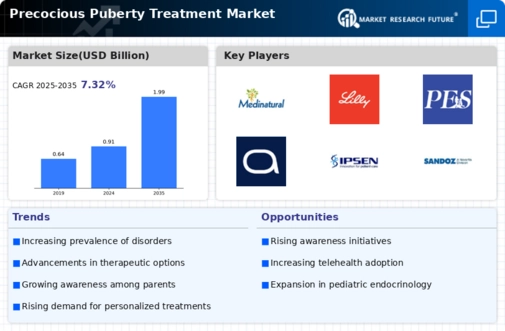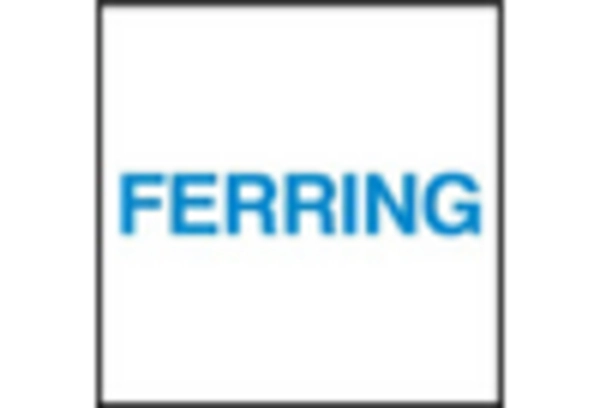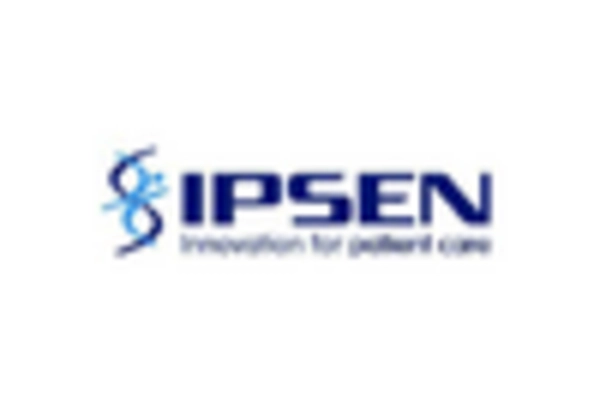Growing Parental Awareness
The heightened awareness among parents regarding the implications of precocious puberty is likely to drive the Precocious Puberty Treatment Market. Parents are becoming increasingly informed about the potential psychological and physical challenges associated with early puberty, prompting them to seek medical advice and intervention. This trend is reflected in the growing number of consultations with pediatric endocrinologists and healthcare providers. As parents recognize the importance of timely treatment, the demand for effective therapies is expected to rise. This shift in parental attitudes not only influences treatment-seeking behavior but also encourages healthcare systems to prioritize the management of precocious puberty, thereby fostering market growth.
Increased Healthcare Expenditure
The rise in healthcare expenditure across various regions is a notable driver for the Precocious Puberty Treatment Market. As governments and private sectors allocate more funds towards healthcare, there is a corresponding increase in the availability of resources for treating conditions like precocious puberty. Reports indicate that healthcare spending has been on an upward trajectory, with many countries investing in pediatric healthcare services. This increase in funding allows for better access to specialized treatments and therapies, which may lead to improved outcomes for children experiencing precocious puberty. Consequently, this trend is expected to positively impact the market, as more families seek effective treatment options.
Enhanced Research and Development
The ongoing advancements in research and development within the field of endocrinology are likely to bolster the Precocious Puberty Treatment Market. Pharmaceutical companies and research institutions are increasingly focusing on developing innovative therapies and medications aimed at managing precocious puberty. For instance, the introduction of GnRH analogs has shown promise in effectively delaying the progression of puberty in affected children. Furthermore, the market is witnessing a surge in clinical trials aimed at evaluating the efficacy and safety of new treatment modalities. This focus on R&D not only enhances treatment options but also contributes to the overall growth of the market, as new therapies become available to healthcare providers.
Rising Incidence of Precocious Puberty
The increasing prevalence of precocious puberty among children appears to be a significant driver for the Precocious Puberty Treatment Market. Recent studies indicate that the incidence of precocious puberty has risen, with estimates suggesting that it affects approximately 1 in 5,000 to 10,000 children. This rise may be attributed to various factors, including environmental influences and changes in lifestyle. As awareness grows regarding the psychological and physical implications of early onset puberty, healthcare providers are more likely to seek effective treatment options. Consequently, this trend is likely to propel the demand for specialized treatments, thereby expanding the market for precocious puberty interventions.
Regulatory Support for Treatment Options
The presence of supportive regulatory frameworks for the treatment of precocious puberty is a crucial driver for the Precocious Puberty Treatment Market. Regulatory agencies are increasingly recognizing the need for effective management strategies for this condition, leading to the approval of various treatment options. For instance, the approval of specific medications aimed at delaying puberty has provided healthcare providers with viable tools to address this issue. Additionally, regulatory support often translates into increased funding for research and development, further enhancing the market landscape. As more treatment options become available and are endorsed by regulatory bodies, the market is likely to experience substantial growth.


















Leave a Comment